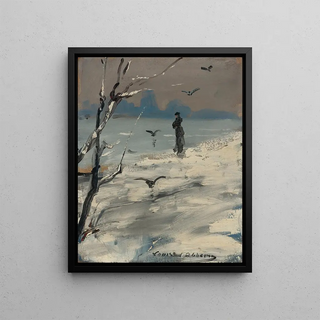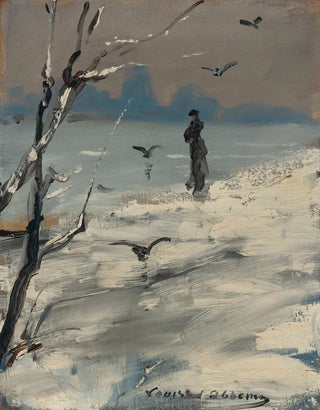Art print | An Elegant Woman Said to Be Sarah Bernhardt During a Winter Walk - Louise Abbéma


View from behind

Frame (optional)
Art print of an Elegant Woman Believed to Be Sarah Bernhardt During a Winter Walk - Louise Abbéma – Captivating Introduction
In the world of art, certain works transcend their era and capture the essence of a remarkable personality. "An Elegant Woman Believed to Be Sarah Bernhardt During a Winter Walk" by Louise Abbéma is one of these creations. This iconic piece, which evokes the grace and charisma of the famous 19th-century actress, immerses us in a wintery atmosphere filled with romance. Through this work, the artist manages to immortalize not only the image of a woman but also the aura of a time when theater and artistic life were in full swing. The scene depicted invites us to contemplate the fleeting beauty of a moment, while transporting us to a universe where elegance and sophistication reign supreme.
Style and uniqueness of the work
Louise Abbéma's style is distinguished by her ability to blend realism and impressionism, creating a unique atmosphere. In this piece, the color palette chosen evokes the softness of an afternoon in winter, where light delicately plays on surfaces. The meticulous details of Sarah Bernhardt's dress, as well as the nuances of shadows and highlights, demonstrate exceptional craftsmanship. The artist succeeds in capturing the movement of the walk, suggesting a natural elegance and lightness that contrast with the coldness of the season. Each brushstroke seems to tell a story, that of a modern and free woman, confidently strolling through a world that belongs to her. This blend of refinement and vibrancy makes this work unforgettable, making it a true masterpiece of its time.
The artist and her influence
Louise Abbéma, often regarded as a pioneer in the art world, knew how to establish herself in a male-dominated environment. Born in 1853, she was a student of great masters and quickly developed her own style, marked by a unique feminine sensitivity. Her connection with Sarah Bernhardt, whom she often depicted, testifies to the reciprocal influence between art and the

Matte finish

View from behind

Frame (optional)
Art print of an Elegant Woman Believed to Be Sarah Bernhardt During a Winter Walk - Louise Abbéma – Captivating Introduction
In the world of art, certain works transcend their era and capture the essence of a remarkable personality. "An Elegant Woman Believed to Be Sarah Bernhardt During a Winter Walk" by Louise Abbéma is one of these creations. This iconic piece, which evokes the grace and charisma of the famous 19th-century actress, immerses us in a wintery atmosphere filled with romance. Through this work, the artist manages to immortalize not only the image of a woman but also the aura of a time when theater and artistic life were in full swing. The scene depicted invites us to contemplate the fleeting beauty of a moment, while transporting us to a universe where elegance and sophistication reign supreme.
Style and uniqueness of the work
Louise Abbéma's style is distinguished by her ability to blend realism and impressionism, creating a unique atmosphere. In this piece, the color palette chosen evokes the softness of an afternoon in winter, where light delicately plays on surfaces. The meticulous details of Sarah Bernhardt's dress, as well as the nuances of shadows and highlights, demonstrate exceptional craftsmanship. The artist succeeds in capturing the movement of the walk, suggesting a natural elegance and lightness that contrast with the coldness of the season. Each brushstroke seems to tell a story, that of a modern and free woman, confidently strolling through a world that belongs to her. This blend of refinement and vibrancy makes this work unforgettable, making it a true masterpiece of its time.
The artist and her influence
Louise Abbéma, often regarded as a pioneer in the art world, knew how to establish herself in a male-dominated environment. Born in 1853, she was a student of great masters and quickly developed her own style, marked by a unique feminine sensitivity. Her connection with Sarah Bernhardt, whom she often depicted, testifies to the reciprocal influence between art and the






